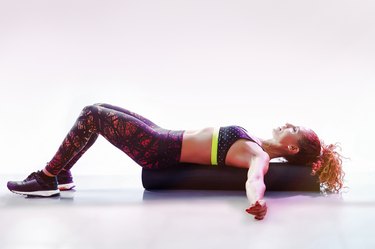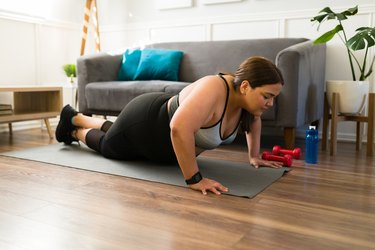
When you decided to breast or chest feed, you may have expected sore nipples from time to time. But one thing you probably didn't anticipate: achy upper-body muscles.
During feedings, you might find yourself rounding your chest forward, slumping your shoulders or craning your neck in awkward ways to get into the perfect nursing position for your little one.
Video of the Day
Often, posture falls low on the priority list when you're trying to make sure your baby is comfortable and well fed, Alissa Licata, FNP-C, IBCLC, a family nurse practitioner and international board-certified lactation consultant, says.
But all that slouching puts a ton of strain on your upper body, which can develop into discomfort.
"Breastfeeding is a common cause of shoulder, upper back and neck pain due to sitting in rounded and sub-optimal positions for prolonged periods of time," Carolyn Wright, PT, DPT, a pelvic health physical therapist at Bespoke Treatments, says.
"These positions can lead to tightening of the muscles in the front of the chest (pectorals) and neck (upper trapezius and levator scapulae) and lengthening and inhibition of the muscles in the upper back (rhomboids, middle and lower trapezius and serratus anterior)," Wright says.
On top of poor posture, "the emotional pressures that may exist during your feeding journey may cause you to hold your breath and tense your muscles, which can then manifest into physical pain," Licata adds.
While discomfort is common during breast/chest feeding, you don't need to grin and bear the pain. There are ways to improve your experience while still providing food for your baby.
One simple strategy to minimize muscle tension: Doing targeted stretches for your shoulders, chest and back. Stretching these areas can offset some of the stress on your upper body and counteract the aches and pains of breast and chest feeding.
5 Upper-Body Stretches for Breast and Chest Feeding
These focused stretches aim to alleviate areas (think: neck, back, chest and shoulders) hit the hardest by prolonged periods of slouching. These movements are gentle on the body, so feel free to do them as many times as needed throughout the day.
1. Foam Roller Snow Angels
"This activity improves the flexibility of the pectoral muscles and improves mobility in the front of the chest," Wright says.
- With your feet on the floor and knees bent, lie vertically on a foam roller that is long enough to support your spine and head (a 24-inch foam roller is recommended).
- Tuck the pelvis so that your back, hips and back of head are supported by the roller.
- Place your arms by your side and let gravity allow them to relax.
- Slowly raise your arms over your head and then back down to your sides (like you’re making snow angels).
- If you feel a particularly tight area, pause and maintain a longer stretch for three to five breaths.
- Continue this movement for 10 to 20 repetitions.
Tip
"If you do not have a foam roller, try using a thick rolled-up towel,” Wright says.
2. Seated Cat-Cow
"This helps to promote thoracic extension to reverse the prolonged rounding of the upper back during breastfeeding," Wright says. Don't want to do this seated? Here's how to perform the traditional cat-cow yoga pose on all fours.
- Sit in a comfortable chair with the feet flat on the floor.
- Place your arms across your chest.
- Round forward, flexing your spine as you exhale, then arch back, opening up the chest and looking up as you inhale.
- Perform 10 to 20 repetitions.
3. Seated Bow and Arrow
"Your thoracic/mid-back extension and rotation becomes limited after sitting in rounded postures for prolonged periods of time," Wright says. This stretch promotes that movement.
- Sit in a comfortable chair with your feet flat on the floor.
- Hold both hands out in front of you with your arms straight.
- Bend your right elbow and stretch your right arm out straight behind you while you rotate to the right.
- Reverse the movement and return to the starting position, then repeat on your left side.
- Perform 10 to 20 repetitions from side to side, inhaling as you rotate behind you and exhaling as you return to the starting position.
4. Doorway Pec Stretch
If it feels like your shoulder blades want a stretch, it might be because they're compensating for tight chest muscles. This move helps to stretch the front of the shoulder that can become tight from breastfeeding.
- Stand in an open doorway or at a squat rack. Raise one arm up, with the elbow bent at 90 degrees, and place your palm on the surface of the door frame or squat rack frame.
- Slowly and gently step forward with the opposite foot until you feel a gentle stretch through the front of your shoulder.
- Perform 10 to 20 repetitions, then switch sides.
5. Kneeling Lat Stretch
With this one shoulder blade stretch, you can target all three muscle groups that tend to tense up during breast or chest feeding while promoting shoulder, chest and back flexibility.
- Kneel on the floor in front of a box or chair.
- Sit back on your heels with your feet together and knees wide (or together if it's more comfortable).
- Place your elbows on the box or chair in front of you and lean forward, so your gaze is facing the floor.
- Holding onto a dowel (or a broomstick or any other similar item), bend the elbows to draw the dowel toward your neck. That's 1 rep.
- Perform 10 to 20 repetitions.
How to Adjust Feeding Position to Decrease Discomfort
In addition to upper-body stretches, making a few minor adjustments to your feeding position can also help you alleviate (or even prevent) upper-body pain.
Try these tiny tweaks to your technique to temper tension in your muscles:
1. Be Mindful of Your Breath and Posture
Sometimes just being more aware of your alignment can help you relax and stop slouching. "Taking a deep breath, leaning back and relaxing your neck and shoulders can help improve discomfort," Licata says.
If this body awareness doesn't come easily (or you're simply too fatigued to remember), ask for assistance. "This is a task that your partner or support person can help with as well by reminding you to not slouch," she adds.
2. Use a Pillow
"Place a supportive pillow or cushion behind your lower back to reduce upper-body straining," Licata says. This little adjustment can lessen "the need to lean forward, which will help to maintain proper alignment," she says.
3. Try Different Feeding Positions
A simple switch to your feeding position can supply a stellar solution for less strain on your upper body.
"Alternating positions between cradle hold, football hold, semi‐reclining, side lying and/or koala hold are just a few various positions that can relieve pressure on these specific areas," Licata says.
4. Get the Right Tools for Pumping
Like breast and chest feeding, pumping can also put pressure on your posture by pulling your upper body into a rounded position. But there are ways to prevent pumping from becoming painful too.
For example, "When you pump, wearing a pumping bra or using a hands‐free pump can allow you to focus on your posture," Licata says.
5. Speak With a Lactation Consultant
If you need a little guidance on feeding position, posture or other nursing related issues, speak with an international board-certified lactation consultant (IBCLC). IBCLCs are health care professionals with expert knowledge in lactation.
"An IBCLC will be able to assess your posture and provide helpful personalized advice to prevent and/or fix upper-body straining," Licata says.
Where to Find Licensed Lactation Consultants
Looking for a lactation consultant? The following organizations can help you locate local credentialed IBCLCs to support and aid you on your nursing journey:
- International Lactation Consultant Association (ILCA)
- The United States Lactation Consultant Association (USLCA)
- La Leche League International
- The Lactation Network
- Boober
- Zip Milk
- Nest Collaborative
“You can also contact your local hospital and/or local [chest/]breastfeeding support groups for IBCLCs in your community,” Licata says.


